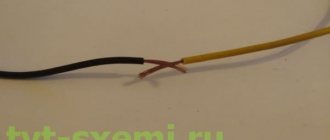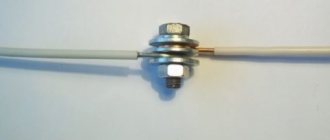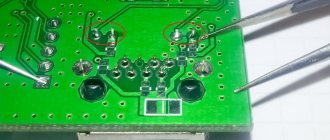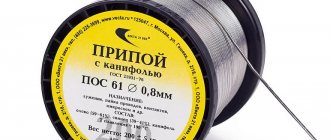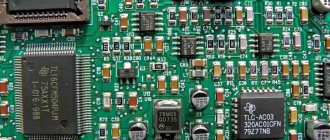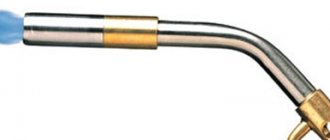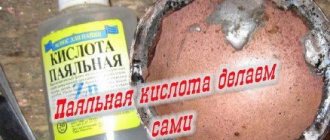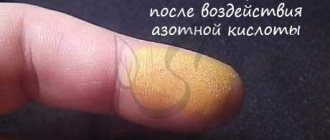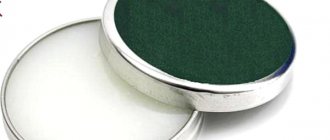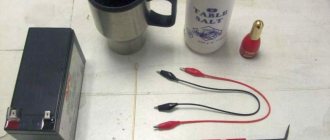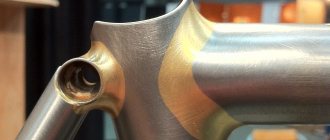Rosin does not always help to properly solder parts to each other, and then soldering acid comes into play, which can remove the oxide film from the surfaces and properly prepare them for soldering. If rosin flux copes well with the “duties” of preparing for joining elements made of copper, then acid compositions tin not only them, but also parts made of copper alloys (brass, bronze), stainless and black steel, nickel, precious metals and even aluminum or cast iron
Figure 1. Soldering acid is needed to remove the oxide film and prepare the surface of the part for soldering.
What are acid fluxes used for?
Acid provides the best environment for solder contact with parts over the largest possible area:
Figure 2. The structure of a salt battery.
- cleaning the treated surfaces from oxides and contaminants;
- protecting them from the resumption of the oxidation process;
- significantly reducing the surface tension of the solder, which allows it to flow more freely.
The result of this is a more reliable connection of the parts being soldered.
Different metals require the use of different soldering acids, but you should immediately understand that acidic fluxes should not be used when assembling circuit boards, because they are an aggressive environment that can have a destructive effect on all their components. In addition, acids are excellent electrical conductors, able to create additional (and unwanted) passage channels for current. You should not rely on neutralization of the acidic environment after soldering.
Specifications
| Characteristic name | Characteristic value |
| Appearance of the substance | Light yellow or colorless liquid |
| Density, g/cm³ | 1,69 |
| Solubility in water | good |
| Vapor pressure force under standard conditions, Pa | 4 |
| Content of orthophosphoric acid in the flux structure, % | 73 |
| Sulfate content, % | 0,35 |
| Amount of iron,% | 0,04 |
| Volume of heavy metals from the group of hydrogen sulfides, % | 0,001 |
| Amount of arsenic,% | 0,0005 |
| Volume of fluorine compounds, % | 0,0005 |
| Tributyl phosphate content, % | 0,0005 |
| Volume of suspended particles, % | 0,05 |
Zinc chloride acid flux
Most often, flux is used to tinning parts to be soldered, which is freely sold in stores. Manufacturers, without further ado, call it “Soldering acid” (Fig. 1). In the annotations for the flux, they indicate the scope of its application. As a rule, this is soldering and tinning of copper, silver and various iron alloys, including cast iron.
The basis of soldering acid is zinc chloride compounds, that is, it is a solution of metal in hydrochloric acid.
Making soldering acid at home
Despite the availability of this active flux in stores, many home craftsmen are interested in whether they can make it themselves. Creating soldering acid is not particularly difficult. To make it you need:
Flux components.
- zinc (Zn);
- concentrated hydrochloric acid (HCl).
To obtain flux, its substances are added in the following proportions:
- 412 g Zn;
- 1 l HCl.
First, zinc is placed in a laboratory container (glass, ceramic, porcelain), and only then hydrochloric acid is poured into the container. It should be poured with extreme caution, and the level of HCl in the container should not exceed ¾ of its volume. After the completion of the dissolution reaction with the release of hydrogen (cessation of the formation of bubbles in the liquid) and clarification to transparency, the finished composition is poured into another tightly sealed container. Hydrochloric acid and granulated zinc are sold in chemical stores, but the metal reagent can also be obtained from used salt batteries (pen-AA batteries) of types “AA”, “AAA”, etc. (Fig. 2).
When preparing active flux yourself, you must take precautions. In laboratory conditions, the reagent is prepared in special cabinets equipped with an exhaust hood. At home, you should use protective equipment for your skin, respiratory system, and eyes. It is better to dissolve zinc outdoors or in a heavily ventilated room, since the reaction actively releases hydrogen. The reagents to produce zinc chloride should be mixed near a water source.
Scheme for washing eyes from flux.
If acid gets on your skin or eyes, the reagent should be washed off with plenty of running water.
A substance spilled on any surface is washed off with a solution of water with an acid-neutralizing alkali (baking soda). A few words should be said about the storage of hydrochloric acid.
Containers with it should be tightly closed and kept in a dark and cool place. Children should not have access to acid.
Pure hydrochloric acid can also be used as a flux. It is used to prepare for soldering iron parts (for example, roofing).
Soldering utensils
How to install a socket with your own hands correctly
Buckets and pans with holes no more than 5-7 mm in diameter are recommended to be soldered without using a soldering iron with POS-60 solder. Leaky places on the dishes can be reliably soldered. To do this, the holes are carefully cleaned with sandpaper from the inside of the container. The hole along the edges is given a conical shape, the cleaned areas are treated with a solution of soldering acid with a brush.
In order to prevent solder leakage from the outside, all bottoms or individual places where holes need to be soldered are covered with thin tin plates. Powdered solder and rosin are poured into the cleaned holes from the inside. The soldering areas are heated over an open fire until the solder melts and fills all the cracks.
For radiators, stripping and soldering are carried out from the outside. To prevent solder from leaking inside, the hole is covered with a plate of tin, galvanized iron, or can be replaced with copper or brass. The choice depends on the material from which the radiator is made. Homogeneous metals and alloys that are similar in composition are easier to solder.
After completing the soldering process of radiators, the internal and external surfaces are thoroughly washed with an alkaline, soapy solution in order to prevent the effect of acidic components on the metal.
Bottle with flux for soldering aluminum
When it is necessary to solder aluminum parts, special solders are used:
- 4:1 mixture of tin and zinc;
- 30:1 mixture of tin and bismuth;
- 99:1 tin and aluminum powder.
The sequence of surface treatment is the same as for preparing iron utensils. In order to properly solder aluminum, rosin is added to the powder, but the melting point must be above 500ºC. It is recommended to stir the solder in the hole, using a thin copper soldering iron tip.
Phosphoric acid flux
Another common soldering acid is phosphoric acid (H3PO4). It successfully removes oxides from metal surfaces and protects them from the formation of new compounds with oxygen, which form a film on the metal that prevents parts from soldering. It is no coincidence that phosphoric acid is included in most products for anti-corrosion treatment of steel structures.
For soldering chromium and nickel alloys, acid is not used in its pure form. Almost 1/3 of the flux consists of ethyl alcohol. H3PO4 accounts for 32%, and rosin accounts for 6% of the composition. In other compositions for tinning and soldering, the volume of acid can reach almost 100%. Often, orthophosphoric acid is diluted together with zinc chloride, the mass content of which in the flux can range from 50% to thousandths of a percent. H3PO4 is used not only for joining parts made of nickel alloys, it is used for soldering products made of low-alloy steel and pure copper or its alloys.
Table of acid fluxes.
Orthophosphoric acid is part of the F-38 N active flux, which is used for soldering:
- alloy, low-carbon and medium-carbon steel;
- copper and its alloys;
- chromium-nickel alloys.
F-38 N is used for soldering in places with difficult access and protects the soldered parts from corrosion. It contains:
- diethylamine hydrochloride;
- H3PO4 (25%).
Phosphoric acid is explosion- and fireproof, but working with it and storing it must be carried out in compliance with all safety precautions. After contact with the skin or eyes, the substance should also be washed off with running water. The duration of washing is at least 10 minutes.
Soldering without a soldering iron
At home, if you don’t have a soldering iron, you can solder copper wires with a diameter of up to 2 mm. For soldering radiators and utensils, special solder, blowtorches, and gas torches are used, since the copper rod of the soldering iron is not able to heat a large surface area. There are several ways:
- Tinning and soldering wires in molten solder . The wire is first heated, applied to a piece of rosin, it melts and spreads evenly over the surface of the connection. The wire is twisted and lowered into molten solder in a tin can over a fire; it can be heated with a blowtorch. In order to solder the twist, it is advisable to hold it in boiling tin for up to 1 minute. The copper wires will heat up and the alloy will fill all the gaps between the twisted wires. In this way you can solder small parts made of copper, brass and other alloys.
Tinned and soldered copper wire
- Soldering wires in the trench . The stripped and twisted wires are laid in a 2-3 cm piece of aluminum tube, 0.5-1 cm in diameter, sawn lengthwise. The top is filled with a mixture of fine shavings of solder and rosin dust, and from the bottom this structure is heated with a lighter, candle or small blowtorch.
Heating the solder with a blowtorch (torch)
The mixture melts and thoroughly envelops all wire connections. After hardening, the aluminum gutter is removed and the joint is insulated.
Solder shavings can be sharpened with a coarse file.
- A thin copper wire up to 0.75 mm can be laid on aluminum foil, sprinkled with a mixture of rosin and tin shavings, wrapped tightly and heated for 3-4 minutes. The solder will evenly fill all the elements at the soldering site; after cooling, the foil can be removed and discarded.
Fluxes made from aspirin and salicylic acid
One of the craftsmen, not finding rosin or other flux in the house, thought of using ordinary aspirin to treat the elements before soldering. Acetylsalicylic acid tablets can be used to repair household appliances. True, when aspirin is heated, caustic vapors are formed, so you should work with acetylsalicylic flux in a ventilated area. One way to tinning is to sprinkle aspirin powder on the part. In another way, the wires are placed on a whole tablet and heated with a soldering iron.
VTS flux is produced based on salicylic acid, which is often used in electrical installations. This composition provides protection to welded parts from corrosion, so it is preferred when carrying out this type of operation. HTS is used for processing copper and its alloys, as well as elements made of precious metals. The flux contains:
- solution of salicylic acid and ethanol (C2H5OH) – 6.3%;
- triethanolamine – 6.3%;
- technical petroleum jelly – 63%.
Precautionary measures
Aggressive properties require a special approach to safety precautions. Storage is carried out in original packaging, protected from direct sunlight.
It is better to carry out work with good ventilation, using the necessary protective equipment.
The skin reacts negatively to aggressive substances. If it gets on your hands, wash it immediately with water and laundry soap. Inhalation may cause oral irritation, and if it gets into the eyes, seek professional help.
How to treat parts with acid
Liquid fluxes are applied to surfaces with a brush. In this case, a more accurate and uniform wetting of the elements to be soldered is ensured, so the brush should be included in any soldering kit. At the same time, as already written above, both more active fluxes and less active ones, to one degree or another, have a destructive effect on both the connected surfaces and the solder. If the flux is not removed at the end of the work, then on steel parts, for example, rusting processes will occur at a much faster pace.
To prevent this, after soldering, parts coated with flux must be treated with neutralizers. The simplest of them is water. To remove F-38 N, you don’t need to use anything other than it. Soda neutralizes well the effects of hydrochloric, orthophosphoric, and acetylsalicylic acid, as it is a base. After soldering, a soda solution should be applied to the parts, which is then washed off with water. Residues of VTS are removed with alcohol or acetone.
Components and physicochemical properties
Orthophosphoric acid has the form of a light yellow solution or a discolored mass. The main component in the composition is zinc chloride, the share of which is at least 50 percent. According to accepted standards, the proportion of insoluble sediment should not exceed 0.001 percent of the total mass of the substance. The allowed ammonia content is within 0.5 percent.
As the formula H3PO4 shows, orthophosphoric acid is tribasic and has medium strength. When interacting with stronger acids, it shows signs of amphotericity, and the result of the reaction is the formation of phosphorite. Contact with water causes the process of electrolytic dissociation to occur.
Acid belongs to the category of substances with a fairly high degree of danger, so when working, care should be taken to prevent it from getting into the eyes and skin through the use of personal protective equipment. It should also be taken into account that due to the aggressiveness of the environment, there is a risk of a negative impact on thin parts and elements. Orthophosphoric acid demonstrates its best qualities when soldering metals with a high melting point.
